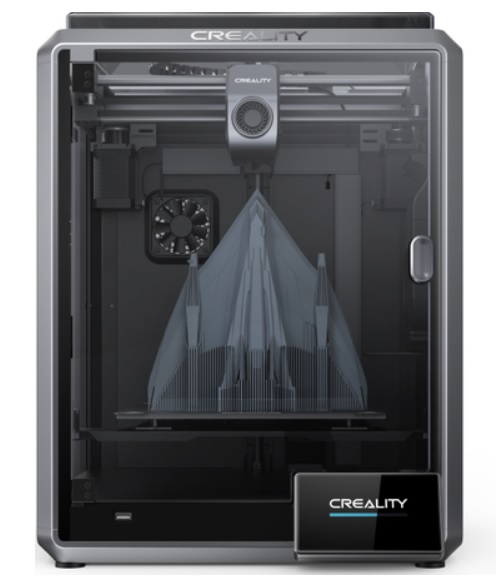Compare K1C vs K1 Max
Comparison between the best 3D printers
Choose the best 3D printer at the best price. The cheapest 3D printers are here.
Buy a 3D printer here with 3D Fila.
 |
 |
|
| Model | K1C[BUY K1C] |
K1 Max[BUY K1 Max] |
| Printing Material | Filament | Filament |
| Buy Filament for Creality 3D K1C | Buy Filament forCreality 3D K1 Max | |
| Estimated price | $449,00 | $1300,00 |
| Manufacturer | Creality 3D | Creality 3D |
| Release Year | 2024 | 2023 |
| Print Volume [mm] | 220x220x250 | 300x300x300 |
| Printer Size [mm] | 355x355x480 | 435x462x526 |
| Weight [kg] | 12,4 | 18 |
| Power Loss Recovery | YES | YES |
| Enclosed printer | YES | YES |
| Bed Leveling | Automatic | Automatic |
| Filament End Sensor | YES | YES |
| Bed type | Heated | Heated |
| Power supply system | Direct Drive | Direct Drive |
| Standard nozzle | 0,4 | 0,4 |
| Maximum Nozzle Temperature [°C] | 300 | 300 |
| Maximum Bed Temperature [°C] | 120 | 100 |
| Maximum printing speed [mm/s] | 600 | 600 |
| Filament holder | YES | YES |
| Camera for supervision | YES | YES |
| Recommended filaments | ABS, PLA, PETG, PET, TPU, PA, ABS, ASA, PC, PLA-CF, PA-CF, PET-CF | ABS, PLA, PETG, TPU, PA, ASA, PC, PLA-CF, PA-CF, PET-CF |
| Recommended slicers | Creality Print; Cura, Simplify3D e PrusaSlicer | Creality Print, Cura, Simplify, Slic3r, IdeaMaker e outros |
| Maximum Resolution [mm] | 0,1 | 0,1 |
| Processor | ||
| Display | Display touchscreen 4,3'' | Display touchscreen 4,3'' |
| Power Supply | 110/220V / 350W | |
| Connectivity | Ethernet / USB / Wi-Fi | USB / Wi-Fi / Ethernet |
| Operating systems | Windows, Mac, Linux | Windows, Mac, Linux |
| Date of registration in the system | 2024-05-16 | 2023-12-01 |
| Release date | 2024 | 2023 |
| Extra features | The Creality K1C is a fully enclosed CoreXY 3D printer featuring an all-metal extruder, tri-metal Unicorn nozzle for abrasive materials, automatic bed leveling with nozzle cleaning, AI-assisted failure detection, built-in camera for timelapse, enhanced cooling system, root access to Klipper firmware, and compatibility with PLA-CF, PA-CF, PET-CF, TPU, ABS, and more. | The Creality K1 Max stands out as a fast Core XY 3D printer with a large build volume of 300 x 300 x 300 mm. It is fully enclosed and equipped with AI sensors to prevent print failures. This model has a smooth and flexible PEI build platform, and uses an automatic leveling system with LIDAR, as well as a filament run-out sensor. LAN, Creality Cloud and USB Flash Disk connectivity are available, as well as a 4.3-inch touchscreen interface. The K1 Max is robust, weighing in at 18 kg, and includes an AI camera and limited version of the Klipper firmware. Its motion system is solid and the printer is efficient with high-temperature filaments, but it is not silent. Assembly is 99% complete, requiring only minor adjustments before use. |
| Support for multiple colors and materials (AMS and CFS) | NO | NO |
Notes * |
||
| Cost-benefit | 8 / 10 | 7 / 10 |
| Hardware | 5.4 / 10 | 4.8 / 10 |
| Tela | . | . |
| Print volume | 3 / 10 | 4 / 10 |
| Performance | 5 / 10 | 5 / 10 |
| [BUY K1C] | [BUY K1 Max] |
Conclusion |
| In comparing the Creality K1C and K1 Max 3D printers, key differences in specifications, functionality, and price point become apparent, guiding potential buyers in their purchasing decisions. The K1C offers a more budget-friendly option with a robust feature set that includes a smaller print volume, making it an ideal choice for hobbyists or those with limited space. Its fully enclosed design, automatic bed leveling, and advanced cooling system contribute to its versatility in handling a variety of filament types. Notably, it also includes AI-assisted failure detection and a built-in camera, enhancing the user experience for those who appreciate monitoring their prints remotely. On the other hand, the K1 Max, while more expensive, boasts a larger build volume and additional advanced features, such as a LIDAR leveling system and enhanced motion dynamics. This model is tailored for users who require greater capacity for larger projects and desire a robust machine capable of handling high-temperature filaments efficiently. While it may lack some of the K1C's unique features, its design and operational capacities make it suitable for more demanding printing tasks. Both printers feature similar connectivity options, touchscreen interfaces, and make use of direct drive systems, ensuring smooth filament feeding. However, the additional weight of the K1 Max suggests a more robust construction, which may translate to greater stability during high-speed printing. Ultimately, the decision between the K1C and K1 Max hinges on the user’s specific needs, budgetary constraints, and intended applications. The K1C stands out as a strong value proposition for beginners or casual users, while the K1 Max caters to professionals looking for larger print volumes and higher performance capabilities. Users should weigh these factors alongside the cost-benefit analysis to determine which model best fits their printing aspirations. |

